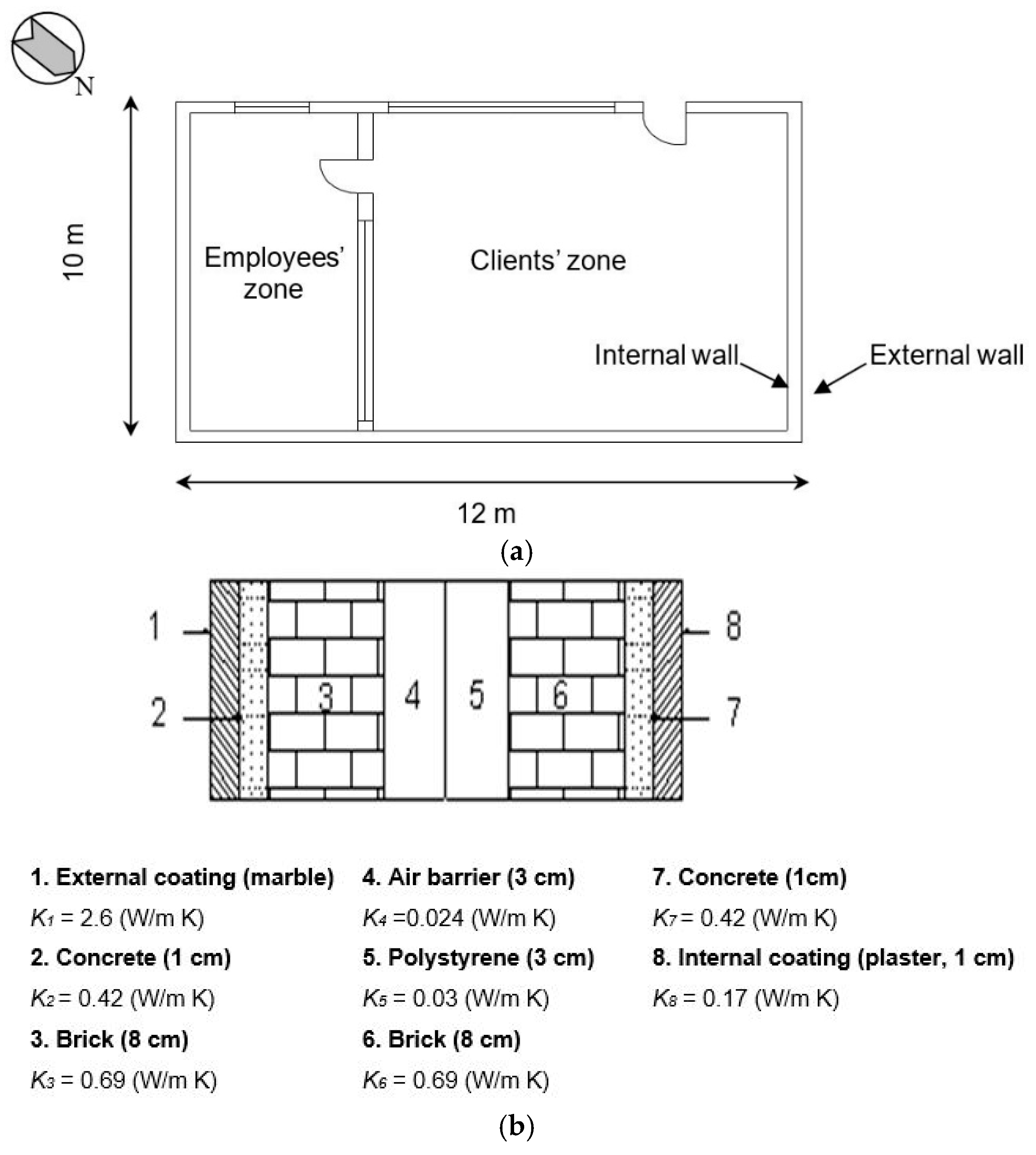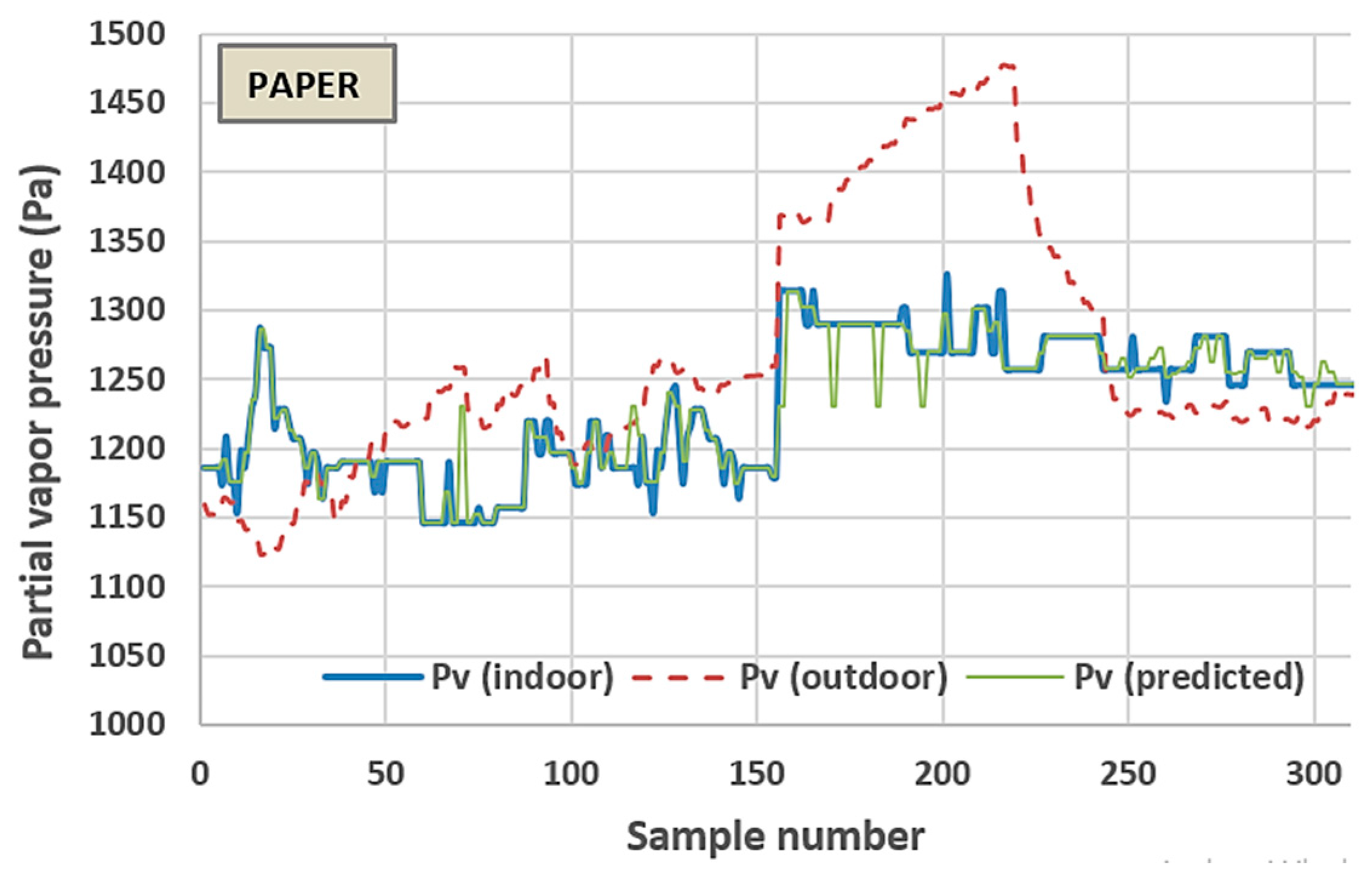A Novel Method for nZEB Internal Coverings Design Based on Neural Networks
Abstract
:1. Introduction
2. Materials and Methods
2.1. Office Buildings
2.2. Sampled Variables and Mathematical Models
2.3. Neural Nets Predictions and Software Resources
- Selection of NNT: There are different types of nets such as Multi-Layer Feedforward Network (MLF), Generalized Regression Neural Nets (GRN) and Probabilistic Neural Nets (PN). In an MLF net, the user must define the topology (number of layers and nodes), while, in a GRN/PN net, there is no need to make topology decisions and two hidden layers are employed. It must be remembered that the net topology is the selection of the number of layers and the number of nodes in the layer that determines the network capacity to learn the relationship between independent and dependent variables. At the same time, the main literature conclusions [25,26,27,28] about network topology are that a single hidden layer with few nodes is sufficient for most cases. Considering that this was the first of its kind study, a probabilistic neural network (GRN/PN) was selected to reach a precision level during the training and testing processes, as shown in Figure 2.
- Control algorithm: it is important to highlight that the error, which is measured as the mean square difference between the actual output value and the output value obtained from the net while training the numerical prediction, is employed as the control parameter to stop the training process.
- Prevention of over-training: NNT needs to prevent over-training. Over-training is when the net not only learns the general relations between variables and is very near to the particular case employed during the training. In this sense, as a normal validation procedure a part of the training data—usually 20% of the sampled data—is employed to test the net once it is trained.
- Input variables: the minimum number of input values to train a network was considered. As the sampling process of temperature and relative humidity during the unoccupied period of the offices was about 10 min, the number of values obtained for each variable during few other nights can be considered sufficient to train and test a neural net.
3. Results
3.1. ANN Selection and Training
3.2. Validation Results
3.3. Internal Coverings Behaviour Characterisation
4. Discussion
5. Conclusions
Author Contributions
Funding
Acknowledgments
Conflicts of Interest
References
- Padfield, T. The Role of Absorbent Building Materials In Moderating Changes of Relative Humidity. Ph.D. Thesis, The Technical University of Denmark, Kgs. Lyngby, Denmark, October 1998. [Google Scholar]
- Hens, H. Indoor Climate in Student Rooms: Measured Values. IEA-EXCO Energy Conservation in Buildings and Community Systems Annex 41 “Moist-Eng” Glasgow Meeting. 2004. Available online: https://www.researchgate.net/publication/237716820_Indoor_climate_in_student_rooms_measured_values (accessed on 24 March 2019).
- Cromwijk, J.; Mateo-Cecilia, C.; Jareño-Escudero, C.; Schröpfer, V.; Op’t Veld, P. An introduction to a novel and rapid nZEB skill-mapping and qualification framework methodology. Buildings 2017, 7, 107. [Google Scholar] [CrossRef]
- EBC Annex 41. Available online: http://www.iea-ebc.org/projects/project?AnnexID=41 (accessed on 27 April 2019).
- Kalagasidis, A.S. Ham-Tools-An Integrated Simulation Tool for Heat Air and Moisture Transfer Analysis in Building Physics. Ph.D. Thesis, Chalmers University of Technology, Gothenburg, Sweden, January 2004. [Google Scholar]
- Orosa, J.A.; Baaliña, A. Passive climate control in Spanish office buildings for long periods of time. Build. Environ. 2008, 43, 2005–2012. [Google Scholar] [CrossRef]
- Orosa, J.A.; Baaliña, A. Improving PAQ and comfort conditions in Spanish office buildings with passive climate control. Build. Environ. 2009, 44, 502–508. [Google Scholar] [CrossRef]
- Orosa, J.A.; Oliveira, A.C. Energy saving with passive climate control methods in Spanish office buildings. Energy Build. 2009, 41, 823–828. [Google Scholar] [CrossRef]
- Orosa, J.A.; Oliveira, A.C. Reducing energy peak consumption with passive climate control methods. Energy Build. 2011, 43, 2282–2288. [Google Scholar] [CrossRef]
- Orosa, J.A.; Oliveira, A.C.; Ramos, N.M.M. Experimental quantification of the operative time of a passive HVAC system using porous covering materials. J. Porous Media Palgrave Macmillan 2010, 13, 637–643. [Google Scholar] [CrossRef]
- Mazzeo, D.; Oliveti, G.; Arcuri, N. A method for thermal dimensioning and for energy behavior evaluation of a building envelope PCM layer by using the characteristic days. Energies 2017, 10, 659. [Google Scholar] [CrossRef]
- Chou, J.S.; Bui, D.K. Modeling heating and cooling loads by artificial intelligence for energy-efficient building design. Energy Build. 2014, 82, 437–446. [Google Scholar] [CrossRef]
- Buratti, C.; Lascaro, E.; Palladino, D.; Vergoni, M. Building behavior simulation by means of artificial neural network in summer conditions. Sustainability 2014, 6, 5339–5353. [Google Scholar] [CrossRef]
- Tian, Q.; Zhao, W.; Wei, Y.; Pang, L. Thermal environment prediction for metro stations based on an RVFL neural network. Algorithms 2018, 11, 49. [Google Scholar] [CrossRef]
- Xu, X.; Feng, G.; Chi, D.; Liu, M.; Dou, B. Optimization of performance parameter design and energy use prediction for nearly zero energy buildings. Energies 2018, 11, 3252. [Google Scholar] [CrossRef]
- Ngo, N.T. Early predicting cooling loads for energy-efficient design in office buildings by machine learning. Energy Build. 2019, 182, 264–273. [Google Scholar] [CrossRef]
- Ballarini, I.; De Luca, G.; Paragamyan, A.; Pellegrino, A.; Corrado, V. Transformation of an office building into a nearly zero energy building (nZEB): Implications for thermal and visual comfort and energy performance. Energies 2019, 12, 895. [Google Scholar] [CrossRef]
- Taleb, H.M. Using passive cooling strategies to improve thermal performance and reduce energy consumption of residential buildings in U.A.E. buildings. Front. Archit. Res. 2014, 3, 154–165. [Google Scholar] [CrossRef] [Green Version]
- Nematchoua, M.K.; Tchinda, R.; Orosa, J.A.; Andreasi, W.A. Effect of wall construction materials over indoor air quality in humid and hot climate. J. Build. Eng. 2015, 3, 16–23. [Google Scholar] [CrossRef]
- Khan, H.S.; Asif, M.; Mohammed, M.A. Case study of a nearly zero energy building in Italian climatic conditions. Infrastructures 2017, 2, 19. [Google Scholar] [CrossRef]
- Orosa, J.A.; Oliveira, A.C. Passive Methods as a Solution for Improving Indoor Environments; Springer-Verlag London Limited: London, UK, 2012. [Google Scholar]
- Ahmad, T.; Chen, H.; Guo, Y.; Wang, J. A comprehensive overview on the data driven and large scale based approaches for forecasting of building energy demand: A review. Energy Build. 2018, 165, 301–320. [Google Scholar] [CrossRef]
- Gemini Data Loggers 2016. Available online: http://www.geminidataloggers.com (accessed on 24 March 2019).
- Hameury, S.; Lundstrom, T. Contribution of indoor exposed massive wood to a good indoor climate: In situ measurement campaign. Energy Build. 2004, 36, 281–292. [Google Scholar] [CrossRef]
- Karkalos, N.E.; Efkolidis, N.; Kyratsis, P.; Markopoulos, A.P. A comparative study between regression and neural networks for modeling Al6082-T6 alloy drilling. Machines 2019, 7, 13. [Google Scholar] [CrossRef]
- Neto, F.C.; Geronimo, T.M.; Cruz, C.E.D.; Aguiar, P.R.; Bianchi, E.E.C. Neural models for predicting hole diameters in drilling processes. Procedia CIRP 2013, 12, 49–54. [Google Scholar] [CrossRef]
- Singh, A.K.; Panda, S.S.; Pal, S.K.; Chakraborty, D. Predicting drill wear using an artificial neural network. Int. J. Adv. Manuf. Technol. 2006, 28, 456–462. [Google Scholar] [CrossRef]
- Nalbant, M.; Gokkaya, H.; Toktas, I. Comparison of regression and artificial neural network models for surface roughness prediction with the cutting parameters in CNC turning. Model. Simul. Eng. 2007, 2007, 92717. [Google Scholar] [CrossRef]
- MatlabWorks 2016. Create, Train, and Simulate Neural Networks. Available online: https://www.mathworks.com/products/neural-network.html (accessed on 26 April 2019).
- Oh, J.; Hong, T.; Kim, H.; An, J.; Jeong, K.; Koo, C. Advanced strategies for net-zero energy building: Focused on the early phase and usage phase of a building’s life cycle. Sustainability 2017, 9, 2272. [Google Scholar] [CrossRef]
- Lu, S.; Wang, R.; Zheng, S. Passive optimization design based on particle swarm optimization in rural buildings of the hot summer and warm winter zone of China. Sustainability 2017, 9, 2288. [Google Scholar] [CrossRef]
- Prabal-Talukdar, U.; Das, A.; Alagirusamy, R. Effect of structural parameters on thermal protective performance and comfort characteristic of fabrics. J. Text. Inst. 2017, 108, 1430–1441. [Google Scholar] [CrossRef]
- Trník, A.; Vozár, L. Modeling of heat capacity peaks and enthalpy jumps of phase-change materials used for thermal energy storage. Int. J. Heat Mass Transf. 2017, 107, 123–132. [Google Scholar] [CrossRef]










© 2019 by the authors. Licensee MDPI, Basel, Switzerland. This article is an open access article distributed under the terms and conditions of the Creative Commons Attribution (CC BY) license (http://creativecommons.org/licenses/by/4.0/).
Share and Cite
Orosa, J.A.; Vergara, D.; Costa, Á.M.; Bouzón, R. A Novel Method for nZEB Internal Coverings Design Based on Neural Networks. Coatings 2019, 9, 288. https://doi.org/10.3390/coatings9050288
Orosa JA, Vergara D, Costa ÁM, Bouzón R. A Novel Method for nZEB Internal Coverings Design Based on Neural Networks. Coatings. 2019; 9(5):288. https://doi.org/10.3390/coatings9050288
Chicago/Turabian StyleOrosa, José A., Diego Vergara, Ángel M. Costa, and Rebeca Bouzón. 2019. "A Novel Method for nZEB Internal Coverings Design Based on Neural Networks" Coatings 9, no. 5: 288. https://doi.org/10.3390/coatings9050288
APA StyleOrosa, J. A., Vergara, D., Costa, Á. M., & Bouzón, R. (2019). A Novel Method for nZEB Internal Coverings Design Based on Neural Networks. Coatings, 9(5), 288. https://doi.org/10.3390/coatings9050288





